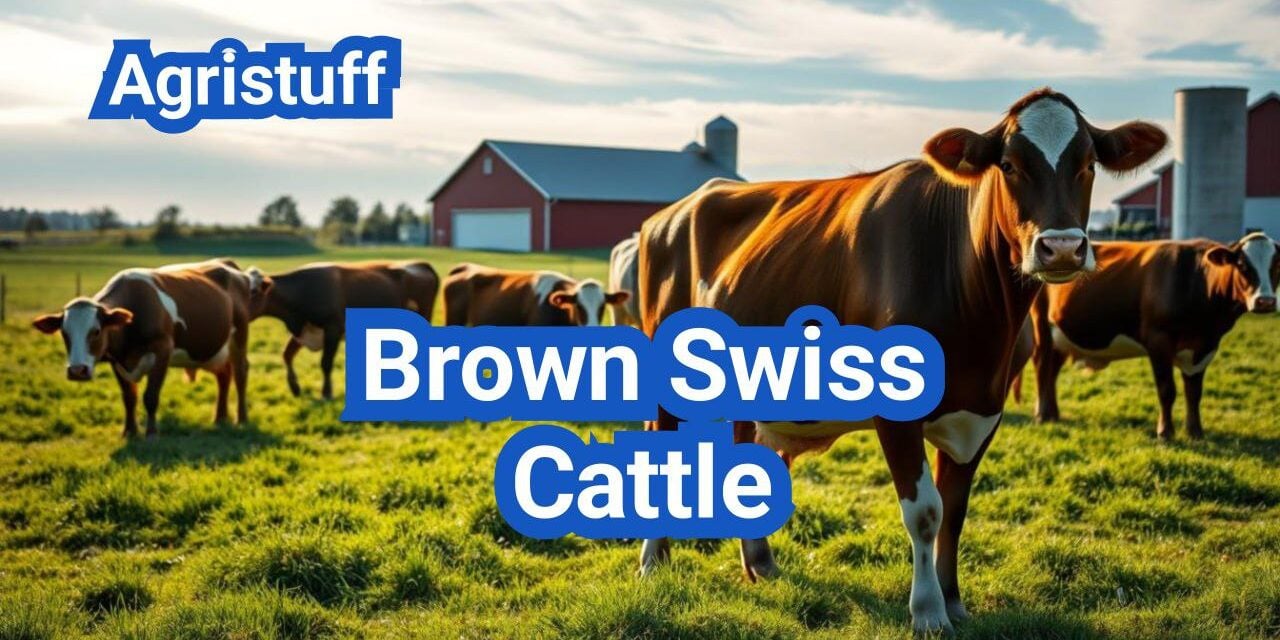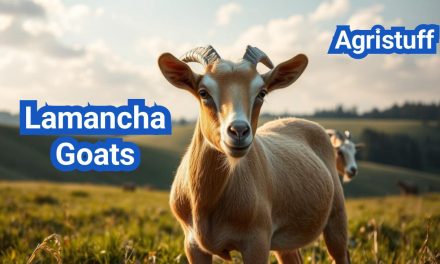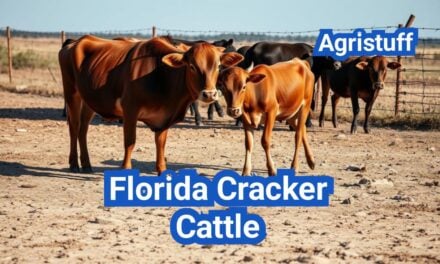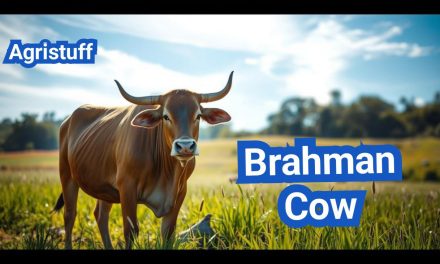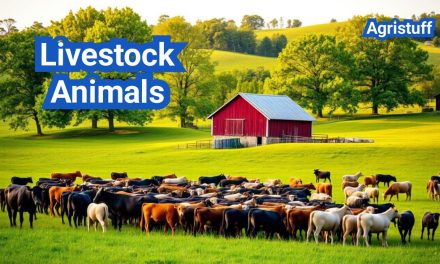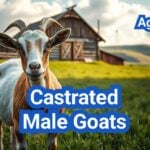The Brown Swiss Cattle breed has a rich history that spans over 4,000 years, originating from the north-eastern part of Switzerland. Known for their robust build and high milk production, this dairy breed has been a significant part of dairy farming.
Developed primarily as a dairy breed, Brown Swiss are recognized for their rich milk composition and adaptability. Their history and characteristics make them a vital component in the dairy industry.
Key Takeaways
- Originated in the north-eastern part of Switzerland over 4,000 years ago.
- Known for robust build and high milk production.
- Rich milk composition and adaptability.
- Significant in dairy farming.
- Primary use is for dairy production.
The Rich Heritage of Brown Swiss Cattle
The history of Brown Swiss cattle is a long and storied one, beginning in the rugged terrain of the Swiss Alps over four millennia ago. This ancient breed has a rich heritage that spans centuries, with its origins deeply rooted in the mountainous regions of Switzerland.
Ancient Beginnings: The 4,000-Year Journey
The journey of the Brown Swiss cattle began over 4,000 years ago in the Swiss Alps, where they were first bred for their strength, hardiness, and milk production capabilities. The breed’s early development was influenced by the local farming practices and the harsh Alpine climate, which contributed to its robust nature and adaptability.
Historical records indicate that the Brown Swiss was among the earliest dairy breeds to be domesticated, playing a crucial role in the agricultural practices of the region. Their ability to thrive in challenging environments made them invaluable to local farmers.
From Swiss Alps to Global Pastures
As global trade and agricultural practices evolved, the Brown Swiss cattle were introduced to new regions, gradually becoming a global dairy breed. Their introduction to North America and other parts of the world marked the beginning of a new era for the breed, as it adapted to diverse farming systems and climates.
The versatility and productivity of the Brown Swiss cattle have made them a popular choice among dairy farmers worldwide. Today, they are recognized for their contribution to milk production and are valued for their hardiness and longevity.
The Brown Swiss Cattle Origin is a testament to the breed’s enduring legacy, from its ancient roots in the Swiss Alps to its current status as a respected dairy breed globally.
Origin and Development of the Brown Swiss Breed

With roots tracing back to the Swiss Alps, the Brown Swiss cattle breed has evolved significantly over time. The breed’s development is a testament to the careful selection and breeding practices of farmers over centuries.
Swiss Mountain Origins
The Brown Swiss breed originated in the mountainous regions of Switzerland, where they were valued for their hardiness and ability to thrive in challenging terrain. The harsh Alpine climate and geography played a significant role in shaping the breed’s characteristics, including their robust constitution and high milk production capabilities.
Evolution Through the Centuries
Over the centuries, the Brown Swiss breed has undergone significant development through selective breeding. Farmers in Switzerland carefully selected animals with desirable traits, such as high milk yield and resistance to disease, to breed future generations. This selective breeding program contributed to the breed’s distinctive characteristics and its reputation as a premier dairy breed.
The evolution of the Brown Swiss breed was also influenced by its dual-purpose use – both for milk and meat production. This dual-purpose capability helped maintain the breed’s popularity among farmers, as it provided a versatile source of income.
Introduction to North America
The Brown Swiss breed was introduced to North America in the late 19th century, where it quickly gained popularity among dairy farmers. The breed’s hardiness, high milk production, and adaptability to different climates made it an attractive choice for farmers in the United States and Canada.
The introduction of Brown Swiss cattle to North America marked a significant milestone in the breed’s development, as it expanded its global presence and further diversified its gene pool. Today, the Brown Swiss remains a significant dairy breed in North America, valued for its milk production and durability.
It’s worth noting that while the terms “Braunvieh” and “Brown Swiss” are sometimes used interchangeably, they refer to related but distinct breeds. Braunvieh is the original breed from which the Brown Swiss was developed. Understanding the differences between Braunvieh and Brown Swiss is crucial for farmers and breeders looking to select the most appropriate breed for their needs.
Physical Characteristics of Brown Swiss Cattle
Brown Swiss cattle exhibit a unique combination of size, color, and conformation that makes them a notable dairy breed. Their physical characteristics are crucial for their dairy farming success.
Size and Weight Specifications
Brown Swiss cattle are known for their substantial size and weight. Mature cows typically weigh between 1,000 to 1,800 pounds, while bulls can weigh 1,800 to 2,500 pounds. Their size and weight contribute to their robust build and ability to produce high-quality milk.
- Mature cows: 1,000-1,800 pounds
- Mature bulls: 1,800-2,500 pounds
- Height at withers: 55-60 inches for cows
Distinctive Color and Appearance
The Brown Swiss breed is easily recognizable due to its distinctive brown coat color, which can range from light brown to dark brown. Their coat is often accompanied by a lighter stripe along the back, and they may have a lighter color around the muzzle and eyes.
Structural Features and Conformation
The structural features of Brown Swiss cattle include a strong, sturdy build with a broad chest and well-sprung ribs. Their udders are well-attached, with good teat placement, making them suitable for milking. The breed’s conformation is characterized by a straight or slightly convex profile and a strong, muscular build.
- Strong, sturdy build
- Broad chest and well-sprung ribs
- Well-attached udders with good teat placement
The combination of these physical characteristics makes Brown Swiss cattle an ideal choice for dairy farming, offering both durability and high milk production potential.
Temperament and Behavioral Traits

Brown Swiss cattle are celebrated for their docile nature and impressive intelligence. This breed has gained popularity worldwide due to its calm demeanor and ease of handling, making it an ideal choice for dairy farmers.
Docile Nature and Handling Ease
The docile nature of Brown Swiss cattle is one of their most significant advantages. They are known to be gentle and even-tempered, which simplifies handling and management on farms. This trait is particularly beneficial for large-scale dairy operations where cattle are handled frequently.
Key benefits of their docile nature include:
- Easier handling during milking and veterinary procedures
- Reduced stress for both cattle and handlers
- Improved overall farm safety
Intelligence and Trainability
Brown Swiss cattle are also recognized for their high intelligence and trainability. They quickly adapt to milking routines and can learn to respond to various commands and signals. This intelligence makes them more efficient to manage and integrate into dairy farming systems.
Their intelligence is demonstrated through:
- Rapid learning of milking routines
- Adaptability to new environments and handling practices
- Responsive behavior to farm management practices
Social Behavior in Herds
Brown Swiss cattle exhibit strong social behavior within herds. They form close bonds with other members of their group and establish a hierarchical structure. Understanding and managing this social behavior is crucial for maintaining a harmonious and productive herd.
Aspects of their social behavior include:
- Formation of close bonds within the herd
- Establishment of a social hierarchy
- Interactive behavior that promotes a stable herd environment
How to Select Quality Brown Swiss Cattle
To ensure optimal dairy farming, it’s essential to know how to select quality Brown Swiss cattle. The selection process involves a comprehensive evaluation of several critical factors that determine the overall quality and productivity of the cattle.
Evaluating Physical Traits
When selecting Brown Swiss cattle, evaluating their physical traits is crucial. This includes assessing their size, weight, and overall conformation. A well-conformed animal is more likely to have a longer productive life. The ideal Brown Swiss cow should have a sturdy build, a deep body, and well-attached udders.
The breed is known for its distinctive brown color, which can range from light silver to dark brown. The coat should be smooth and glossy, indicating good health. Additionally, the cattle should have strong feet and legs, as these are essential for their mobility and overall longevity.
Reviewing Production Records
Production records are a vital tool in selecting quality Brown Swiss cattle. These records provide information on the cattle’s milk yield, fat content, and protein levels. Reviewing these records helps farmers identify high-producing animals. When evaluating production records, it’s essential to consider the cattle’s lactation history and any notable achievements in milk production.
| Production Trait | Average Value | High-Producing Value |
|---|---|---|
| Milk Yield (lbs) | 22,000 | 25,000+ |
| Fat Content (%) | 4.0 | 4.2+ |
| Protein Levels (%) | 3.5 | 3.7+ |
Health History Considerations
The health history of Brown Swiss cattle is another critical factor to consider during the selection process. A cattle’s health history can provide insights into its resilience and susceptibility to certain diseases. Farmers should look for cattle with a history of good health and low somatic cell counts, as these are indicators of udder health and overall well-being.
“The health of your cattle is directly related to their productivity and longevity. Ensuring that you select cattle with a strong health history is crucial for the success of your dairy operation.”
By carefully evaluating physical traits, reviewing production records, and considering health history, dairy farmers can make informed decisions when selecting Brown Swiss cattle. This thorough approach helps ensure the selection of high-quality cattle that will contribute to the success and profitability of their dairy farming operations.
Brown Swiss Cattle Breeding Practices

Effective breeding practices are essential for the continued improvement of Brown Swiss cattle. The breed’s success in dairy farming is significantly attributed to well-planned breeding programs that focus on reproductive traits, genetic improvement, and selection criteria.
Reproductive Traits and Gestation
Brown Swiss cattle are known for their robust reproductive traits. The gestation period for Brown Swiss cows is approximately 290 days, which is comparable to other dairy breeds. Their reproductive efficiency is a key factor in the breed’s popularity among dairy farmers.
Reproductive Characteristics:
- Age at first calving: 24-28 months
- Calving interval: 12-13 months
- Conception rate: High due to good fertility
Breeding Programs and Selection Criteria
Breeding programs for Brown Swiss cattle involve careful selection based on production records, genetic merit, and physical characteristics. The American Brown Swiss Association provides resources and guidelines for breeders to improve their herds.
Selection Criteria:
- Milk production and composition
- Conformation and structural soundness
- Genetic diversity to avoid inbreeding
Genetic Improvement Strategies
Genetic improvement in Brown Swiss cattle is achieved through selective breeding and the use of advanced reproductive technologies such as artificial insemination (AI) and genomic testing. These strategies help in identifying superior genetics and accelerating genetic progress.
The following table summarizes key aspects of Brown Swiss cattle breeding practices:
| Breeding Aspect | Description | Benefit |
|---|---|---|
| Reproductive Traits | Robust fertility, 290-day gestation | Efficient reproduction cycle |
| Selection Criteria | Milk production, conformation, genetic diversity | Improved herd quality |
| Genetic Improvement | AI, genomic testing | Accelerated genetic progress |
Crossbreeding with Brown Swiss

Crossbreeding programs involving Brown Swiss cattle aim to capitalize on hybrid vigor to boost milk production and overall herd health. By combining the genetic strengths of Brown Swiss with other dairy breeds, farmers can achieve significant improvements in dairy productivity and profitability.
Popular Crossbreeding Combinations
Brown Swiss cattle are often crossed with other popular dairy breeds to create high-performing dairy cows. Some of the most common crossbreeding combinations include:
- Brown Swiss x Holstein: Known for high milk production and robust health.
- Brown Swiss x Jersey: Combines the high butterfat content of Jerseys with the durability of Brown Swiss.
- Brown Swiss x Montbéliarde: Offers a balance between milk production and fertility.
Hybrid Vigor Benefits
The primary benefit of crossbreeding with Brown Swiss is the phenomenon known as hybrid vigor or heterosis. This results in offspring that are more robust and productive than either of their parents. The benefits include:
- Increased milk production
- Improved fertility rates
- Enhanced disease resistance
- Better longevity
Hybrid Vigor Benefits Table
| Trait | Purebred | Crossbred |
|---|---|---|
| Milk Production | 20,000 lbs | 22,000 lbs |
| Fertility Rate | 80% | 85% |
| Disease Resistance | Moderate | High |
Considerations for Successful Crossbreeding
While crossbreeding with Brown Swiss offers numerous benefits, there are several factors to consider for a successful program:
- Selection of appropriate breeds to cross with Brown Swiss.
- Clear breeding objectives, such as improving milk production or enhancing fertility.
- Effective management practices to ensure the health and productivity of crossbred animals.
Dairy Excellence: Milk Production and Quality

The Brown Swiss breed is celebrated for its significant contribution to the dairy industry through its superior milk production. This section delves into the specifics of their dairy excellence, focusing on milk yield statistics, milk composition, and the advantages of their milk for cheese production.
Milk Yield Statistics
Brown Swiss cattle are known for their impressive milk yield. On average, a Brown Swiss cow produces between 22,000 to 24,000 pounds of milk per year. This high production level is a result of their genetic makeup and robust health.
The average milk production per lactation for Brown Swiss cows is around 9,000 kg, with a fat content of 4.0% and a protein content of 3.5%. This makes their milk highly sought after for dairy products.
Milk Composition and Components
The milk of Brown Swiss cattle is not only produced in large quantities but is also rich in quality. It contains an optimal balance of fat, protein, and other components that are crucial for the production of high-quality dairy products.
The milk composition includes a higher percentage of fat and protein compared to some other breeds, which enhances the nutritional value and taste of the milk.
Cheese Yield Advantages
One of the significant advantages of Brown Swiss milk is its suitability for cheese production. The higher fat and protein content in their milk result in a higher cheese yield, making them particularly valuable for cheese manufacturers.
The cheese yield advantage is a critical factor in the dairy industry, as it directly impacts the profitability of dairy farming and cheese production operations.
Brown Swiss vs. Other Dairy Breeds
Brown Swiss cattle are renowned for their rich milk production and durability, but a comparison with other dairy breeds reveals unique advantages. As dairy farmers consider the best breed for their operations, understanding the differences between Brown Swiss and other popular dairy breeds is crucial.
Brown Swiss vs. Holstein Comparison
When comparing Brown Swiss to Holstein cattle, several key differences emerge. Holsteins are known for their high milk production, but Brown Swiss cattle offer advantages in terms of longevity and milk composition.
- Milk Production: Holsteins produce more milk in terms of quantity, but Brown Swiss milk is often preferred for its higher butterfat and protein content.
- Longevity: Brown Swiss cattle are known for their longevity, often staying in production longer than Holsteins.
- Health: Brown Swiss tend to have fewer health issues, particularly regarding their udders and feet.
Advantages Over Jersey and Other Breeds
Brown Swiss cattle also have several advantages when compared to Jersey and other dairy breeds. Their size, milk production, and adaptability make them a versatile choice for dairy farmers.
- Size and Adaptability: Brown Swiss are generally larger than Jerseys and can adapt to a variety of farming systems.
- Milk Quality: While Jerseys are known for their rich milk, Brown Swiss offer a balance between quantity and quality.
- Hardiness: Brown Swiss are known for their hardiness and ability to thrive in different climates.
Braunvieh vs. Brown Swiss: Understanding the Difference
It’s also important to distinguish between Braunvieh and Brown Swiss cattle, as they are related but distinct breeds. Braunvieh is the original breed from which Brown Swiss was developed.
- Origin: Braunvieh originated in Switzerland and was used to develop the Brown Swiss breed.
- Characteristics: While both are robust, Braunvieh tends to be larger and has been used for both milk and meat production.
- Usage: Brown Swiss has been bred more specifically for dairy production, whereas Braunvieh has a dual-purpose use.
Understanding these differences is crucial for dairy farmers looking to select the best breed for their specific needs and production goals.
Brown Swiss Cattle in the United States

With a heritage spanning centuries, Brown Swiss cattle have become an integral part of American dairy farming. Their introduction to the United States marked the beginning of a new chapter in their history, one that would see them thrive in a new environment.
Historical Development in America
The first Brown Swiss cattle were imported to the United States in the 19th century. This period was significant for American dairy farming, as it introduced a new breed that would contribute to the country’s dairy production. The breed’s hardiness and milk production capabilities made it an attractive choice for American dairy farmers.
Adaptation to the American climate and farming practices was key to the breed’s success. Over time, Brown Swiss cattle proved to be resilient and productive, traits that endeared them to farmers across the country.
Current Population and Distribution
Today, Brown Swiss cattle are found across the United States, with a significant presence in dairy farming regions. Their distribution reflects the breed’s adaptability to various climates and farming systems.
The American Brown Swiss Association plays a crucial role in maintaining the breed’s standards and promoting its benefits. The association is involved in breed registration, genetic evaluation, and marketing efforts to support Brown Swiss breeders.
The American Brown Swiss Association
The American Brown Swiss Association is dedicated to the advancement of the Brown Swiss breed in the United States. It provides a range of services to its members, including breed registration, genetic testing, and educational resources.
The association’s efforts have been instrumental in the breed’s continued success, ensuring that Brown Swiss cattle remain a viable and competitive choice for dairy farmers.
Health Management and Longevity

Effective health management is key to maximizing the lifespan of Brown Swiss cattle. Their longevity is one of the breed’s most significant advantages, contributing to their economic viability on dairy farms.
Disease Resistance and Common Health Issues
Brown Swiss cattle are generally known for their robust health and disease resistance. However, like all breeds, they are not immune to certain health issues. Common problems include mastitis, reproductive issues, and metabolic disorders.
Disease prevention strategies are crucial and include vaccination programs, maintaining hygiene, and regular veterinary check-ups.
Udder Health and Somatic Cell Count (SCC)
Udder health is a critical aspect of dairy cow health management. Brown Swiss cattle are praised for their udder traits, which contribute to lower Somatic Cell Counts (SCC) and reduced incidence of mastitis.
Regular milking practices, proper udder care, and genetic selection for udder health traits can significantly improve the overall udder health of the herd.
| Udder Health Trait | Description | Benefit |
|---|---|---|
| Udder Attachment | Strong attachment reduces the risk of mastitis | Lower SCC |
| Teat Placement | Proper teat placement eases milking and reduces mastitis risk | Improved Milking Efficiency |
Feet and Leg Strength
The longevity of Brown Swiss cattle is also attributed to their feet and leg strength. Strong feet and legs reduce the risk of lameness, a common issue in dairy cattle that can lead to reduced productivity and increased culling rates.
Proper hoof care, including regular trimming and monitoring for signs of lameness, is essential for maintaining the health and mobility of the herd.
Adaptability and Environmental Tolerance

Brown Swiss cattle are celebrated for their ability to adapt to a wide range of environmental conditions, making them a versatile choice for dairy farmers worldwide. This adaptability is a crucial factor in their global popularity.
Thermotolerance and Climate Adaptation
Brown Swiss cattle exhibit a high degree of thermotolerance, enabling them to thrive in both temperate and tropical climates. Their ability to adapt to different temperatures is attributed to their robust physiology and coat characteristics.
Thermotolerance Benefits: The breed’s thermotolerance means that they can maintain productivity in hot climates, making them an excellent choice for dairy farming in regions with high temperatures.
Altitude Performance
Brown Swiss cattle have shown remarkable performance at high altitudes, where other breeds might struggle due to lower oxygen levels. Their ability to adapt to altitude is beneficial for farming in mountainous regions.
High-Altitude Advantages: The breed’s capacity to thrive at high elevations expands the potential for dairy farming in areas that might be challenging for other breeds.
Grazing Behavior and Feed Efficiency
The grazing behavior of Brown Swiss cattle is efficient, allowing them to make the most of available pasture. Their feed efficiency contributes to their overall productivity and sustainability in dairy farming operations.
| Characteristic | Description | Benefit |
|---|---|---|
| Thermotolerance | Ability to adapt to various temperatures | Maintains productivity in hot climates |
| Altitude Performance | Thrives at high elevations | Expands dairy farming potential in mountainous regions |
| Grazing Behavior | Efficient grazing habits | Optimizes pasture use and feed efficiency |
Raising Brown Swiss Cattle: A Practical Guide

The key to raising healthy Brown Swiss cattle lies in understanding their housing requirements, nutritional needs, and implementing proper daily care routines. Effective management practices are crucial for the well-being and productivity of these cattle.
Housing Requirements
Providing suitable housing for Brown Swiss cattle is essential for their health and productivity. The housing should protect them from extreme weather conditions, such as high temperatures, cold, and precipitation. A well-ventilated barn with adequate bedding, like straw or sand, is recommended. The barn should be designed to allow for easy cleaning and manure management.
The layout of the housing facility should also consider the space needed for the cattle to stand up, lie down, and move around comfortably. Adequate space helps in reducing stress among the animals.
Feeding and Nutrition Management
Brown Swiss cattle are known for their high milk production, and their dietary needs are significant. A balanced diet that includes high-quality forages, such as hay or silage, and concentrates is essential. The nutritional requirements vary depending on the stage of lactation, pregnancy, and growth.
It’s crucial to ensure that the cattle have access to clean water at all times. A well-managed feeding program should be in place to monitor the nutritional intake and adjust as necessary to maintain optimal health and productivity.
Daily Care Routines
Daily care routines for Brown Swiss cattle include regular milking, monitoring health, and maintaining cleanliness. Milking should be done at consistent times each day, and the milking equipment should be properly sanitized to prevent mastitis.
Regular health checks are vital to identify any signs of illness or injury early. This includes monitoring for signs of lameness, checking the udder for mastitis, and observing overall behavior and appetite.
By focusing on these key areas, farmers can ensure the well-being of their Brown Swiss cattle and optimize their productivity.
Economic Aspects of Brown Swiss Ownership
Understanding the economic aspects of Brown Swiss cattle is crucial for farmers considering this breed. The decision to invest in these cattle involves several financial considerations.
Initial Investment Considerations
The initial investment in Brown Swiss cattle includes the purchase price of the animals, infrastructure costs such as barn construction or renovation, and equipment for milking and feeding. The quality and price of the cattle can vary significantly based on factors like breeding, age, and health status.
- Purchase price of cattle
- Infrastructure development
- Equipment and machinery
Farmers should also consider the cost of registering the cattle with the relevant breed association, which can provide access to pedigree information and breeding programs.
Operational Costs and Management
Operational costs for Brown Swiss cattle include feed, veterinary care, and labor. Efficient feeding strategies can significantly impact the overall profitability of the dairy operation.
- Feed costs: High-quality feed is essential for maintaining milk production levels.
- Veterinary care: Regular health checks and preventive measures can reduce the incidence of disease.
- Labor costs: Skilled labor is necessary for the daily care and milking of the cattle.
Managing these costs effectively is crucial for maintaining profitability. Farmers can explore cost-saving measures such as rotational grazing and optimizing milking routines.
Return on Investment Potential
The return on investment (ROI) for Brown Swiss cattle comes primarily from milk sales, but can also include sales of breeding stock and, in some cases, meat production. The high milk yield and quality of Brown Swiss cattle contribute to their potential for a strong ROI.
“The profitability of dairy farming with Brown Swiss cattle is influenced by milk price, production level, and operational efficiency.” – Dairy Farming Expert
Farmers should conduct thorough economic analyses, considering both the costs and potential revenues, to make informed decisions about investing in Brown Swiss cattle.
Dual-Purpose Capabilities of Brown Swiss Cattle
Brown Swiss cattle are renowned for their dual-purpose capabilities, serving both dairy and meat production needs. This versatility makes them an attractive option for farmers looking to diversify their agricultural output.
Meat Production Qualities
Brown Swiss cattle are not only valued for their milk production but also for their meat production qualities. They offer a robust carcass with good marbling, which enhances the tenderness and flavor of the meat. The breed’s ability to produce high-quality beef makes it a popular choice among farmers who practice dual-purpose farming.
Key characteristics of Brown Swiss meat production include:
- Good growth rates
- High-quality carcass
- Desirable marbling
Secondary Products and Uses
In addition to milk and meat, Brown Swiss cattle contribute to the production of various secondary products. Their hides can be used for leather production, and their manure serves as a valuable fertilizer for agricultural lands. This multifunctionality adds to the overall economic benefits of raising Brown Swiss cattle.
The utilization of secondary products can significantly enhance the profitability of a farm.
| Product | Description | Use |
|---|---|---|
| Milk | High-quality dairy product | Cheese, butter, and other dairy products |
| Meat | Beef with good marbling | Fresh beef, processed meat products |
| Hides | Leather production | Shoes, belts, handbags |
| Manure | Organic fertilizer | Agricultural land fertilization |
Versatility in Different Farming Systems
Brown Swiss cattle can thrive in various farming systems, from intensive dairy operations to more extensive beef production systems. Their adaptability to different climates and management practices makes them a versatile choice for farmers worldwide.
The ability of Brown Swiss cattle to fit into different farming systems enhances their appeal to a broad range of farmers. Whether it’s a small-scale farm or a large commercial operation, Brown Swiss cattle can contribute to the success of the enterprise.
Sustainability and Future Prospects
As the world shifts towards more sustainable agricultural practices, the role of Brown Swiss cattle becomes increasingly important. Their unique characteristics and adaptability make them a valuable asset in modern dairy farming.
Environmental Impact
The environmental impact of Brown Swiss cattle is a significant consideration in their sustainability. These cattle are known for their efficiency in feed conversion and their ability to thrive on pasture-based diets, which can reduce the carbon footprint associated with intensive grain-based dairy farming systems.
Efficient Feed Conversion: Brown Swiss cattle are praised for their ability to convert feed into milk efficiently, which is crucial for reducing the environmental impact of dairy farming. This efficiency means that less feed is required to produce the same amount of milk, potentially lowering greenhouse gas emissions.
“The efficiency of feed conversion in Brown Swiss cattle not only benefits the farmer economically but also contributes to a more sustainable dairy production system.”
Role in Sustainable Agriculture
Brown Swiss cattle play a vital role in sustainable agriculture due to their hardiness, longevity, and adaptability to various farming systems. They can be integrated into diverse agricultural practices, from intensive dairy farming to more extensive grazing systems.
| Characteristics | Contribution to Sustainability |
|---|---|
| Hardiness | Reduced need for veterinary interventions, improving overall farm sustainability. |
| Longevity | Longer productive life reduces the need for replacement animals, lowering the environmental impact. |
| Adaptability | Ability to thrive in various climates and farming systems, supporting diverse agricultural practices. |
Future Breeding Directions
The future of Brown Swiss cattle breeding will focus on enhancing their sustainability and environmental adaptability. Breeding programs will aim to improve traits such as feed efficiency, disease resistance, and longevity.
Genetic Selection: Advances in genetic selection will play a crucial role in the future breeding of Brown Swiss cattle. By selecting for desirable traits, breeders can improve the sustainability of these cattle.
The integration of Brown Swiss cattle into sustainable agricultural systems not only supports environmental stewardship but also contributes to the long-term viability of dairy farming.
The Enduring Value of Brown Swiss Cattle
The Brown Swiss cattle breed has established itself as a cornerstone in dairy farming due to its robust build, high milk production, and adaptability. As a Dairy Cattle Breed, it offers a unique combination of traits that make it invaluable to dairy farmers. The Brown Swiss Cattle Value lies in its ability to thrive in various environments, making it a versatile choice for dairy operations worldwide.
Throughout this article, we have explored the rich heritage, physical characteristics, and breeding practices of Brown Swiss cattle. Their significance in dairy farming is underscored by their high milk yield and quality, as well as their longevity and disease resistance. As the dairy industry continues to evolve, the Brown Swiss Cattle Conclusion is that this breed will remain a vital component of dairy farming due to its numerous benefits.
In conclusion, the Brown Swiss breed is a valuable asset for dairy farmers seeking a reliable and productive dairy cattle breed. Its enduring value is a testament to the breed’s strength and the important role it plays in modern agriculture.
FAQ
What is the origin of the Brown Swiss cattle breed?
The Brown Swiss cattle breed originated in the north-eastern part of Switzerland over 4,000 years ago.
What are the distinctive characteristics of Brown Swiss cattle?
Brown Swiss cattle are known for their robust build, high milk production, and rich milk composition. They have a distinctive brown color and are recognized for their docile nature and intelligence.
How much milk does a Brown Swiss cow produce?
Brown Swiss cows are known for their high milk production. The average milk yield varies, but they are generally recognized for producing high-quality milk with a rich composition.
What is the difference between Braunvieh and Brown Swiss cattle?
Braunvieh and Brown Swiss are related breeds, but they have distinct differences. Braunvieh is a dual-purpose breed originating from Switzerland, while Brown Swiss is primarily a dairy breed developed from Braunvieh genetics.
Are Brown Swiss cattle suitable for crossbreeding?
Yes, Brown Swiss cattle are often used in crossbreeding programs due to their hybrid vigor benefits, which can improve milk production and overall herd health.
What are the advantages of raising Brown Swiss cattle?
The advantages of raising Brown Swiss cattle include their high milk production, rich milk composition, docile nature, and adaptability to various climates and farming systems.
How do Brown Swiss cattle compare to Holstein cattle in terms of milk production?
While Holstein cattle are known for their high milk yield, Brown Swiss cattle produce milk with a richer composition, making it ideal for cheese production. The choice between the two breeds depends on the dairy farmer’s specific needs.
What is the role of the American Brown Swiss Association?
The American Brown Swiss Association is involved in promoting the breed, maintaining breed standards, and providing resources for breeders and dairy farmers.
How can I ensure the health and longevity of my Brown Swiss cattle?
Ensuring the health and longevity of Brown Swiss cattle involves proper nutrition, regular veterinary care, maintaining udder health, and selecting for feet and leg strength.
Are Brown Swiss cattle adaptable to different environmental conditions?
Yes, Brown Swiss cattle are known for their adaptability and thermotolerance, making them suitable for various climates and altitudes.
What are the economic benefits of owning Brown Swiss cattle?
The economic benefits of owning Brown Swiss cattle include their potential for high milk production, the value of their milk for cheese production, and their versatility in different farming systems.
Can Brown Swiss cattle be used for meat production?
Yes, Brown Swiss cattle can be used for meat production, and they are considered a dual-purpose breed in some contexts, offering both milk and meat production capabilities.
What are the future prospects for Brown Swiss cattle in sustainable agriculture?
Brown Swiss cattle are expected to continue playing a significant role in sustainable agriculture due to their adaptability, disease resistance, and the value of their milk and meat.
Conclusion of: Brown Swiss Cattle
Introduction: why Brown Swiss Cattle matter to U.S. dairies
Brown Swiss Cattle have earned a reputation among American dairy producers for an unusually practical balance of high milk volume, strong component yields, and exceptional durability. From family farms to multi-thousand-cow herds, Brown Swiss Cattle adapt to varied climates, hold up structurally over many lactations, and deliver a calm temperament that simplifies daily routines. If you want a breed that fits fluid milk and cheesemaking markets in the United States, Brown Swiss Cattle are a dependable, data-backed option with deep roots and modern performance. Brown Swiss Association (USA)
History and Alpine origin of Brown Swiss Cattle
Originating in the Swiss Alps as the traditional “Braunvieh,” Brown Swiss Cattle were molded by mountain terrain, pasture-based systems, and a culture centered on milk for cheese. Centuries of selection for hardiness, strong feet and legs, moderate frame, and persistent milk production forged the foundation of the modern breed. The same traits that once mattered on steep Swiss summer pastures now help Brown Swiss Cattle thrive in diverse U.S. housing and management systems. World Brown Swiss Federation
Arrival and growth of Brown Swiss Cattle in the United States
Brown Swiss Cattle arrived in the United States in the late 1860s and quickly established a foothold as a recognized dairy breed. Importations, herd registrations, and participation in dairy shows and official milk recording grew steadily through the early 1900s, laying the groundwork for today’s widespread presence. Brown Swiss Cattle now populate major dairy regions, from the Upper Midwest to pockets of the Northeast and West, supporting fluid milk and specialty cheese markets. Oklahoma State University – Breeds of Livestock
Breed identification: the look of Brown Swiss Cattle
Typical Brown Swiss Cattle range in color from light silver-brown to dark chocolate, often with a black-pigmented muzzle encircled by a light hair ring, dark hooves, and a broad head. The breed’s balanced frame, adequate capacity, level rumps, and snug, well-attached udders are hallmarks that fit modern milking systems. For buyers, judges, and herd managers, these visual cues make Brown Swiss Cattle easy to spot and evaluate consistently. Brown Swiss Association (USA)
Size, growth, and structural advantages of Brown Swiss Cattle
As a large framed dairy breed, mature Brown Swiss Cattle cows often weigh around 1,300–1,500 lb, with bulls significantly larger. That mass supports udder capacity, metabolic resilience, and sound locomotion when paired with correct feet and legs. Many producers credit Brown Swiss Cattle with lasting an extra lactation or two compared with average herd mates, thanks to frame strength and joint integrity, which reduces replacement pressure and stabilizes cash flow. Penn State Extension – Dairy
Temperament: calm, workable Brown Swiss Cattle
Daily handling matters, and Brown Swiss Cattle are widely regarded as docile, steady cows that tolerate crowds, parlor flow, and routine health work without excessive stress. Calmer cattle generally mean safer crews, smoother breeding and hoof-trimming sessions, and fewer management disruptions. While any herd needs consistent stockmanship, many U.S. dairies report that Brown Swiss Cattle make it easier to keep people and animals relaxed and productive. National Dairy FARM Program
Milk yield and components from Brown Swiss Cattle
On 305-day mature-equivalent records, Brown Swiss Cattle are known for steady volume paired with strong fat and protein yields that convert to checks, not just bragging rights. The protein-to-fat balance aligns with cheesemaking economics, and the breed’s persistent lactations help smooth seasonality. When formulating rations and negotiating premiums, many farms find Brown Swiss Cattle bring both pounds and solids to the table. USDA Economic Research Service – Dairy
Cheesemaking value: why processors like Brown Swiss Cattle
Because cheese yield hinges on milk solids, Brown Swiss Cattle—with reliable protein and butterfat—often match the needs of plants producing Cheddar, Swiss-type, and specialty cheeses. Their component profile, combined with consistent lactation curves, can support higher value per hundredweight in markets that reward solids. In regions such as Wisconsin and New York, this fit helps Brown Swiss Cattle anchor milk supply for artisan and industrial cheese processors alike. University of Wisconsin – Dairy Extension
Longevity and productive life of Brown Swiss Cattle
Longevity drives profit through fewer replacements and more mature-cow lactations. Brown Swiss Cattle frequently excel in productive life metrics because their udders hold up, their legs stay sound, and their calm nature reduces injury risk. Spreading rearing costs across extra lactations improves margins, and culling decisions can be more selective when Brown Swiss Cattle remain healthy and profitable into later parities. World Brown Swiss Federation
Climate adaptability: Brown Swiss Cattle in heat and cold
From northern winters to southern summers, Brown Swiss Cattle adapt well to temperature swings when given sensible housing and cooling. Their dense hide and robust physiology help them tolerate cold, while shade, fans, and evaporative cooling protect intake and production during heat spells. The result is fewer dips in output and better animal comfort when Brown Swiss Cattle operate in varied U.S. environments. FAO – Dairy Production & Products
Reproduction strategy and calving targets with Brown Swiss Cattle
Efficient reproduction means breeding heifers to calve at 22–24 months, then maintaining a 12- to 13-month calving interval—benchmarks that fit Brown Swiss Cattle well. Use routine body condition scoring, heat detection (or activity systems), and strategic synchronization to keep days open in check. Balanced selection for fertility traits ensures Brown Swiss Cattle deliver both milk and reproduction goals without sacrificing udder and structural quality. Council on Dairy Cattle Breeding (CDCB)
Udder health and milk quality in Brown Swiss Cattle
Low somatic cell counts, strong fore and rear udder attachments, and correct teat placement are priorities for Brown Swiss Cattle. Consistent bedding management, routine pre- and post-milking hygiene, and timely treatment protocols keep bulk tank SCC in premium ranges. Data-driven sire selection for udder traits complements management and helps Brown Swiss Cattle maintain quality through long, persistent lactations. National Mastitis Council
Breeding goals and genetic improvement of Brown Swiss Cattle
Modern selection indexes let you pursue yield, components, fertility, productive life, and type simultaneously in Brown Swiss Cattle. Stud catalogs and independent proofs offer PTAs for protein, fat, DPR, SCS, and conformation, supporting balanced progress. Genomic tools accelerate gains by identifying elite heifers and bulls early, ensuring today’s Brown Swiss Cattle keep pace with industry benchmarks while preserving their signature durability. Council on Dairy Cattle Breeding (CDCB)
Crossbreeding with Brown Swiss Cattle
Some dairies blend breeds to capture heterosis for fertility, health, and longevity, and Brown Swiss Cattle are often selected as a crossbreeding component for structure and solids. Mating programs may rotate Brown Swiss with Holstein, Jersey, or Scandinavian Red lines to reduce inbreeding and metabolic problems. Track results carefully to confirm that crossbred Brown Swiss Cattle meet your market and management goals. Journal of Dairy Science
Feeding Brown Swiss Cattle for components and consistency
Nutrition plans for Brown Swiss Cattle prioritize high-quality forages, adequate effective fiber, and balanced energy and protein to support milk fat and protein. Monitoring NDF digestibility, starch fermentability, and amino acid balance helps stabilize components and rumen health. Stage-of-lactation grouping and TMR consistency keep Brown Swiss Cattle eating and ruminating, minimizing swings in bulk tank values. University of Minnesota Extension – Formulating Dairy Cow Rations
Heat-stress management for Brown Swiss Cattle
Even with natural resilience, Brown Swiss Cattle lose production under heat load without proactive cooling. Use shade over feed lines, high-velocity fans, soakers or misters with adequate droplet size, and smart holding-pen timing to reduce standing heat. Combine these with plentiful clean water and careful handling to keep Brown Swiss Cattle comfortable and productive in summer. University of Wisconsin – Dairy Extension
Housing, comfort, and daily handling for Brown Swiss Cattle
Comfortable stalls, clean alleys, and non-slip flooring protect the feet and udders of Brown Swiss Cattle. In freestall barns, confirm lunge space, brisket board placement, and bedding depth so cows fully utilize stalls. Low-stress stockmanship, quiet movement, and consistent routines reduce cortisol spikes, supporting intake, reproduction, and milk quality in Brown Swiss Cattle. National Dairy FARM Program
Economics and market fit of Brown Swiss Cattle
Dairy profitability hinges on milk price and cost control, and Brown Swiss Cattle can help on both fronts. In component-priced markets, their solids contribute to higher mailbox prices, while longevity reduces replacement rearing costs and lost production days. For farms selling to cheese plants or value-adding on farm, Brown Swiss Cattle often align well with revenue strategies. USDA ERS – Dairy Market Analysis
Selecting sires and making a Brown Swiss Cattle plan
Start with a written breeding objective that fits your milk market, facilities, and labor, then choose bulls that improve weak points without giving up strengths. For Brown Swiss Cattle, many herds emphasize udder attachments, rear leg set, teat placement, SCS, DPR, and productive life. Review proofs regularly, avoid excessive inbreeding, and align heifer raising so Brown Swiss Cattle calve at the right size and age. Council on Dairy Cattle Breeding (CDCB)
Getting started: sourcing Brown Swiss Cattle and support
Work with reputable breeders, sale managers, and AI representatives who understand Brown Swiss Cattle and local market needs. Ask for production records, linear type scores, health history, and genomic data when available, and visit reference herds to see daughters in milk. National and state associations help you network, benchmark, and keep Brown Swiss Cattle programs on track as your herd grows. Brown Swiss Association (USA)
Final thought
For U.S. dairies that value durability, compositional milk, and a calmer working day, Brown Swiss Cattle deliver a proven, Alpine-bred package that holds up across climates and business models. Pair good genetics with consistent cow comfort and nutrition, and Brown Swiss Cattle will reward you with long, persistent lactations and marketable solids that match America’s cheese-driven demand. UW Dairy Extension – Management Resources
Sources & References
- Brown Swiss Association (USA)
- World Brown Swiss Federation
- Oklahoma State University – Breeds of Livestock
- USDA Economic Research Service – Dairy
- University of Wisconsin – Dairy Extension
- University of Minnesota Extension – Dairy Cow Rations
- Council on Dairy Cattle Breeding (CDCB)
- National Mastitis Council
- FAO – Dairy Production & Products
- Journal of Dairy Science
- Penn State Extension – Dairy
- National Dairy FARM Program

